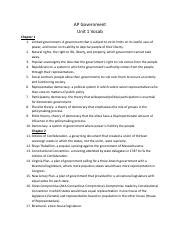In the realm of political science, understanding the fundamental concepts and vocabulary that shape the discipline is paramount. As you delve into Unit 1 of your AP Government course, it is imperative to familiarize yourself with the following terms that will serve as the foundation for your understanding of the American political system:

1. Government and Authority
Government: The institution that exercises authority over a given society, making and enforcing laws, and regulating social and economic activities.
Authority: The power to issue commands and enforce them, based on either legitimate or coercive power.
2. Political Power and Influence
Power: The ability to exert influence over others, shape decisions, or achieve desired outcomes.
Influence: The indirect or subtle ability to affect the behavior or decisions of others.
Legitimacy: The perception that an authority or its decisions are rightful and have the right to rule.
Coercion: The use of force or threats to compel behavior.
3. Constitutionalism and Civil Liberties
Constitution: A document that establishes the fundamental principles and structure of a government, defining its powers and limitations.
Constitutionalism: The principle that government power should be limited and exercised in accordance with the constitution.
Civil Liberties: The fundamental rights and freedoms guaranteed to individuals by the constitution, such as freedom of speech, assembly, and due process.
4. Federalism and Intergovernmental Relations
Federalism: A system of government where power is divided between a central government and smaller regional or local governments.
Intergovernmental Relations: The interactions and relationships between different levels of government, including cooperation, competition, and conflict.
5. Political Ideologies and Party Systems
Political Ideology: A set of beliefs about the role of government, the distribution of wealth and power, and the ideal society.
Party System: The organization and interaction of political parties within a society, competing for power and representing different ideologies.
6. Political Participation and Elections
Political Participation: The activities undertaken by citizens to influence the political system, such as voting, lobbying, and running for office.
Elections: The process by which citizens choose their representatives or make policy decisions by casting ballots.
7. Public Policy and Public Opinion
Public Policy: The decisions and actions taken by government to address societal issues.
Public Opinion: The collective views and attitudes of the public on political issues or candidates.
8. Interest Groups and the Media
Interest Groups: Organizations that represent specific interests or groups and seek to influence government policy.
Media: The means of communication that inform and shape public opinion, including television, newspapers, and social media.
Tables for Understanding
To further enhance your comprehension, here are four tables that summarize key concepts within Unit 1 vocabulary:
| Table 1: Forms of Government | Examples |
|---|---|
| Monarchy | Saudi Arabia |
| Oligarchy | China |
| Democracy | United States |
| Dictatorship | North Korea |
| Table 2: Political Ideologies | Key Beliefs | Examples |
|---|---|---|
| Liberalism | Individual freedom, limited government | Democratic Party |
| Conservatism | Tradition, hierarchy, limited social change | Republican Party |
| Socialism | Government ownership of key industries, social equality | Democratic Socialists of America |
| Table 3: Types of Elections | Purpose | Example |
|---|---|---|
| Primary Election | Select candidates for the general election | Iowa Caucuses |
| General Election | Choose elected officials | Presidential Election |
| Referendum | Voters directly approve or reject a policy | California Proposition 13 |
| Table 4: Sources of Political Power | Type of Power | Source |
|---|---|---|
| Legitimate Power | Perceived as legitimate by followers | Elected officials |
| Coercive Power | Based on force or threats | Military |
| Reward Power | Based on giving rewards | Employers |
| Expert Power | Based on knowledge and skills | Scientists |
Frequently Asked Questions (FAQs)
-
What is the most important term in AP Government Unit 1?
Answer: Government -
Why is constitutionalism important?
Answer: It limits government power and protects individual rights. -
What is the difference between power and influence?
Answer: Power is direct, while influence is indirect. -
How can I increase my political participation?
Answer: Vote, lobby, or run for office. -
What is the role of interest groups in the political system?
Answer: Represent specific interests and influence policy. -
How does the media shape public opinion?
Answer: By providing information, setting agendas, and framing issues. -
What is the difference between a monarchy and a democracy?
Answer: A monarchy is ruled by a single person, while a democracy is ruled by the people. -
What are the key principles of liberalism?
Answer: Individual freedom, limited government, and social progress.
Conclusion
Understanding the vocabulary of AP Government Unit 1 is not simply a matter of memorization. It is a fundamental step towards developing a deeper comprehension of the American political system. By mastering these terms, you will gain the necessary tools to analyze political phenomena, participate effectively in civic discourse, and navigate the complexities of our democracy. Remember, the key to success in AP Government is not only knowing the definitions but also understanding their interconnections and applying them to real-world scenarios. Embrace the journey of political science, and let these terms serve as your compass on the path of civic engagement.
